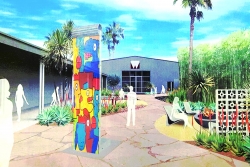Those who could find the Wende Museum of the Cold War, in a non-descript office park off Slauson Avenue and open just one day a week, discovered a collection that gave insight into the lives of East Germans cut off from the West. There were household furniture, statues of Lenin, city maps, paintings and pieces of the Berlin Wall.
Now the museum, after years of planning and fundraising, is moving to a much more visible location in Culver City, at the historic Armory Building on Culver Boulevard, next door to Veterans Memorial Park. It will have free admission and visiting hours Wednesdays to Sundays.
The museum is slated to reopen with a press preview on Friday, Nov. 17; an opening celebration on Saturday, Nov. 18; and a public opening on Sunday, Nov. 19.
There is still a lot to do before the planned November opening, officials said. At a preview of the new location on Oct. 6, drywall was unpainted, pink wall insulation was visible and the outdoor space had yet to be landscaped.
No Cold War relics were on display, but a massive 900-page book of the museum’s collection showed its breadth, including everything from children’s toys to East Germans’ vacation memories to political propaganda.
“It’s been a long haul,” Justinian Jampol, Wende’s founder and executive director said of the five-year fundraising effort and planning for the new space.
Support for the Wende comes from a long list of donors, including the Ahmanson Foundation, Arcadia Fund, the W.M. Keck Foundation and the Ralph M. Parson Foundation. The museum hasn’t reached its $5 million capital campaign goal yet, but enough has been raised for the construction project in the new space, Jampol said
A HISTORIC LOCATION
Culver City Mayor Jeff Cooper said the Armory, a relic of the Cold War, is a fitting home for the Wende.
“It was an armory, so troops would assemble here. They would store Jeeps here [in readiness for a potential attack on the United States],” Cooper said.
The building later was a homeless shelter, but for the last several years, it sat mostly vacant, Cooper added.
The Wende Museum now has a 75-year agreement with the city, for the token rent of $1 a year.
The Armory was built in 1949, just as the Cold War was beginning. Jampol said that Cold War equipment was built in Culver City, including atomic detection devices.
“Culver City, in many ways, is sort of a Cold War town,” he said. “It was seen as a higher security risk. The idea was that if there was going to be a nuclear war, this would be a target. And I think it permeates in some ways in the process of building the museum. The spirit of that era and time is very clear.”
Cooper said the new museum will give visitors one more attraction to patronize Culver City .
“They’re going to have other options here in Culver City to look at our culture, be it the Wende Museum, be it the Mayme Clayton (Library and) Museum across the street, and really get a deeper appreciation for Culver City, and that it’s more than just a bedroom community that has restaurants and movie studios,” he said.
Cooper, city representatives and museum staff welcomed Berlin Mayor Michael Muller at the Oct. 6 preview at the Armory, after touring the former location, which is now closed. Muller congratulated the museum’s leaders on the new spot.
“I think it’s very important to remember our history, so we can learn something about our future,” Muller told visitors at the preview.
DAILY LIFE IN EAST GERMANY
The Wende isn’t a typical history museum, explained Amanda Roth, collections and curatorial associate. It has the military medals and uniforms expected in an institution about the Cold War, but it also presents a fuller picture.
“We collect from all aspects of daily life,” Roth said. “We have children’s toys. We have home movies in the collection. We have vacation pamphlets,” and more than 100,000 items in total. “We have so many different ways of making these personal connections to the collection.”
When it opens in November, the Wende will have two temporary exhibits, plus highlights from its permanent collection. “Cold War Spaces” will explore geographic and ideological “spaces” during the Cold War, and “Russians” will display photos by American photographer Nathan Farb, taken during a 1977 trip to Novosibirsk.
Although the revamped Armory was bare for the Oct. 6 event, renderings on display showed a main exhibition area, narrow corridors containing vaults accessible to visitors and an outdoor landscape that will eventually contain a part of the Berlin Wall.
“The whole idea of the Cold War (is) being about secrets and things hidden behind doors and being opaque. The museum’s all about open access, transparency and engagement,” Jampol explained about the vaults.
The Cold War may have ended almost three decades ago, but with Russia and North Korea in the news today, it’s current, Jampol said.
“It’s really tangible how the past impacts the present,” he said. “It feels more contemporary than it has for a long time.”
The Wende Museum of the Cold War is set to open to the public on Nov. 19 with a community open house at its new location in the Armory Building, 10808 Culver Blvd. in Culver City.

